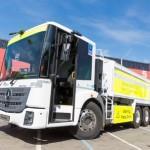Road safety group Road Safety GB has teamed up with Scania to launch an education pack aimed at 10 to 11 year old school children warning of the dangers of heavy goods vehicle blindspots.
Stay safe on the roads includes a tutorial for teachers, a poster explaining the danger spots around trucks and information for parents on road safety.
The pack was launched at a Clocs meeting held on the first day of the Tip-ex and Tank-ex 2015 exhibition in Harrogate.
Road Safety GB chairman Honor Byford said the initiative came about as a result of a meeting at a previous Clocs session and she urged every operator to get involved.
“We will promote it to our members and other organisations,” she said. “We also want operators to provide a vehicle to go into schools. Don’t wait to be asked – make the offer and we will provide the packs. If each of you could get it out to one school we can reach a lot of children, teachers and parents. If you want help we are here to help.”
The Harrogate Clocs session, attended by almost 70 delegates, heard from Glen Davies, Clocs programme manager at TfL, that of 2,000 trucks stopped in the last 18 months by the industrial taskforce - in predominantly targeted checks - 1,500 were non-compliant. “Between 2008 and 2013, 55% of cyclist fatalities involved an HGV – so far in 2015 it was been 100%,” he said. “And HGVs make up less than 4% of traffic in London.”
Hannah White, another programme manager at TfL, said that Clocs required vehicles over 3.5-tonne to eliminate or minimise as far as practical blindspots, a requirement that has been left deliberately vague according to Davies.
“Some technology has been around for a long time but there are now over 45 companies that have come to this market,” he said. “We don’t know what equipment is effective so we have commissioned TRL to come up with a methodology for independent testing. So at the moment we can’t be too specific.”
White said that Clocs was no longer just a London issue, and there were over 28 construction clients – including recent addition Skanska - operating 600 sites championing the standard. Adding in utilities and TfL there were over 3,000 sites now specifying Clocs.
Davies added that as a client spending £11bn a year TfL had aligned its requirements for construction vehicles visiting its sites to Clocs and had recruited a five-strong road risk compliance team to enforce the standard. “There are no excuses for failing to comply,” he said.
Clocs confusion
Addressing the confusion over Clocs and the Fors operator standard, Davies said TfL now required operators to achieve at least Fors bronze standard and that Clocs was built in to the silver standard. There are now 2,900 operators at bronze, 180 at silver and 41 at gold.
Fors, now run by Aecom, has gone national and international; only a third of Fors members are in London and 44 operators based on the continent have signed up.
“Operators can now demonstrate compliance with Clocs through Fors,” Davies explained. “Our remit is within the M25 but our supply chain extends beyond that. So we have made Fors available to other cities and we had a very positive meeting with Leeds yesterday. All the development work has been done so there is not much cost involved in adopting it.”
Turning back to Clocs, Davies said: “It is owned and led by the industry not TfL. There are eight Cycle Ambition cities looking at it and the Clocs working group has co-signed a letter to all eight calling for consistency rather than each city doing its own thing.”
Sean McGrae, senior manager for national transport at Lafarge Tarmac, said it was “vital” to have a single standard to work to. “We run 1,700 trucks but our Aggregates and Asphalt division has 3,500 trucks working for it and we want to affect our supply chain as well as our own fleet,” he said. “We are committed to paying to retrofit our own fleet and that of our contract hauliers and are promoting Clocs as a standard beyond London.”

Cemex has been working for many years on mirrors and camera systems to eliminate blindspots, but over the past three years it worked with Mercedes-Benz and has now opted for a 6x2 Econic low entry cab to improve the direct vision for the driver to the nearside. It had the first of these trucks on show at Tip-ex and has just ordered a second.
This is the route construction products supplier SIG has also gone down. It operates 2,000 curtainsided 6x2 trucks and has also specified the Econic for its urban delivery vehicle fleet. “It gives almost double the direct vision of a conventional truck,” said SIG head of fleet Steve Martin.
The Clocs session heard numerous complaints about the need to “drill holes” in brand new trucks to retrofit the extra mirrors, sensors and cameras required to meet the Clocs standard, and the truck makers were called upon to fit this equipment at the factory.
Scania is doing just that, having teamed up with Brigade to offer Clocs-ready vehicles straight from the dealers in some parts of the country.
You can attend the Tip-ex and Tank-ex show at Harrogate International Centre for free. The only show dedicated to the tipper and tanker market runs until 30 May.














